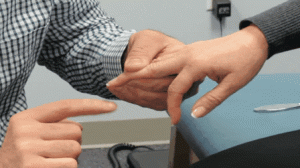 Hoffmann’s reflex is a finding elicited by a reflex test which verifies the presence or absence of problems in the corticospinal tract.
Hoffmann’s reflex is a finding elicited by a reflex test which verifies the presence or absence of problems in the corticospinal tract.
Known also as the finger flexor reflex.
Used as a measure of spinal reflex processing (adaptation) in response to exercise training.
The test involves tapping the nail or flicking the terminal phalanx of the middle or ring finger.
A positive response is seen with flexion of the terminal phalanx of the thumb.
Erroneously called ‘the Babinski’s sign of the upper limb’.
A positive Babinski sign is considered a pathological sign of upper motor neuron disease except for infants, in whom it is normal.
A positive Hoffmann’s sign can be present in an entirely normal patient.
A positive Hoffman’s sign in the normal patients is more commonly found in those who are naturally hyper-reflexive.
A positive Hoffmann’s sign is a worrisome finding of a disease process if its presence is asymmetrical, or has an acute onset.
Hoffman’s reflex is a deep tendon reflex, a monosynaptic reflex pathway in of the spinal cord.
Hoffmann’s reflex is a deep tendon reflex with a monosynaptic reflex pathway in the spinal cord, that is normally fully inhibited by descending input.
The Babinski reflex is more complicated and not a deep tendon reflex, and its pathway is both more complicated.
When both lower and upper neuron damage is indicated, it indicates a motor neuron illness, such as amyotrophic lateral sclerosis.
